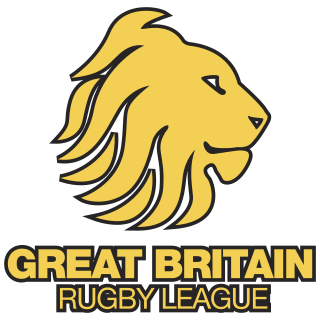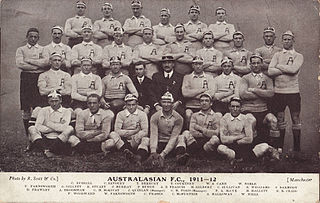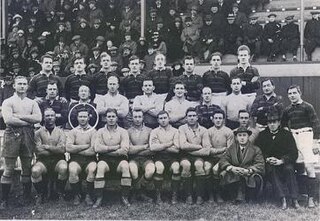
The Great Britain national rugby league team represents Great Britain in rugby league. Administered by the Rugby Football League (RFL), the team is nicknamed The Lions.
The Australian national rugby league team, the Kangaroos, have represented Australia in senior men's rugby league football competitions since the establishment of the game in Australia in 1908. Administered by the Australian Rugby League Commission, the Kangaroos are ranked first in the IRL Men's World Rankings. The team is the most successful in Rugby League World Cup history, having won the competition 12 times, and contested 15 of the 16 finals, only failing to reach the final in the 1954 inaugural tournament. Only five nations have beaten Australia in test matches, and Australia has an overall win percentage of 69%.

The 1911–12 Kangaroo tour of Great Britain was the second ever Kangaroo tour and was actually a tour by an "Australasian" squad that included four New Zealand players in addition to 24 Australian representatives. It took place over the British winter of 1911–12 and this time, to help promote the game of Rugby league in New Zealand, the Northern Rugby Football Union invited a combined Australian and New Zealand team. They became the first tourists to win the Ashes. and the last to do so on British soil for over half a century. The tour was a success in performance and organisation. Matches were well attended, the squad's touring payments were maintained throughout and the players all shared in a bonus at the tour's end.

The 1907–1908 New Zealand rugby tour of Australia and Great Britain was made by a group of New Zealand rugby footballers who played matches in Australia, Ceylon, England and Wales between 1907 and 1908. Most of the matches were played under the rules of the Northern Union, a sport that is today known as rugby league. As such, the team were the immediate predecessors of the New Zealand national rugby league team. The tour had a large role in establishing rugby league in both Australia and New Zealand, and also gave birth to international rugby league. The tour party has come to be known as the professional All Blacks or All Golds, although at the time they were commonly referred to as the All Blacks—a named popularised by the New Zealand rugby union team that toured the Northern Hemisphere in 1905.

The 1921–22 Kangaroo tour of Great Britain was the third ever Kangaroo tour. Again an Australasian side rather than an Australian team alone travelled to Great Britain to contest the Ashes. Coached by Arthur Hennessy and captained by Les Cubitt, the Kangaroos travelled on the RMS Tahiti to England for best-of-three series of Test matches against Great Britain for the Ashes. The tour took place during the 1921–22 Northern Rugby Football Union season and also featured matches against several of the clubs in that competition as well as other representative teams. The tour also involved some degree of player misbehaviour, with one young footballer almost sent home from San Francisco because of all the broken glasses following a drinking session on board the team's ship.
The 1910 Great Britain Lions tour of Australia and New Zealand was the first international tour of the Great Britain national rugby league team, "The Lions". They played the second ever Ashes series against Australia, and their first as the visiting team, before travelling to Auckland to take on New Zealand. The tour was a huge promotional and financial success for what was then known as the "Northern Union" game and helped set the pattern for regular, alternating test match series between Britain and Australia. It is regarded as one of the most important events in the history of rugby league.
The 1914 Great Britain Lions tour of Australia and New Zealand was the second ever British national rugby league team or 'Lions' tour of Australasia, where it was winter and matches were played against the Australian and New Zealand national sides, as well as several local teams. The tour repeated the promotional and financial success of the 1910 Great Britain Lions tour of Australasia and became famous for the third and deciding Ashes test, known as the "Rorke's Drift Test" due to a backs-to-the wall British victory against all odds.
The 1967–68 Kangaroo tour of Great Britain and France was the twelfth Kangaroo Tour, and saw the Australian national rugby league team travel to Europe and play twenty-one matches against British and French club and representative rugby league teams, in addition to three Test matches against Great Britain and three Tests against the French. It followed the tour of 1963-64 and the next was staged in 1973.
The 1963-64 Kangaroo tour was the eleventh Kangaroo tour, during which the Australian national rugby league team traveled to Europe and played thirty-six matches against British and French club and representative teams. It included three Test matches against Great Britain for The Ashes, and three Tests against the French. The tour followed the 1959-60 Kangaroo tour of Great Britain and France and was followed by the 1967-68 Kangaroo tour of Great Britain and France.
Women's rugby league is a popular women's sport in Australia. The sport has a high level of participation in the country both recreational and professional. Australian Rugby League Commission (ARLC) is the national governing body of the sport in Australia, organising the Australian Women's Rugby League, the Australian women's national team, and the nine state governing bodies of the game, among other duties. Women's participation of modern rugby league has been recorded since the early 1920s. It has since become one of Australia's most popular women's team sports.
The 1932 Great Britain Lions tour was a tour by the Great Britain national rugby league team) of Australia and New Zealand which took place between May and August 1932. The tour involved a schedule of 26 games, 18 in Australia including a three-test series against Australia for the Ashes and a further eight in New Zealand including a three-test series against New Zealand.
The 1936 Great Britain Lions tour was a tour by the Great Britain national rugby league team of Australia and New Zealand which took place between May and August 1936. The tour involved a schedule of 24 games, 16 in Australia including a three-test series against Australia for the Ashes and a further 8 in New Zealand including a two-test series against New Zealand.
The 1946 Great Britain Lions tour was a tour by the Great Britain national rugby league team of Australia and New Zealand which took place between April and August 1946. The tour involved a schedule of 27 games: 20 in Australia including a three-test series against Australia for the Ashes, and a further 7 in New Zealand including one test match against New Zealand.
The 1950 Great Britain Lions tour was a tour by the Great Britain national rugby league team of Australia and New Zealand which took place between May and August 1950. The tour involved a schedule of 25 games: 19 in Australia including a three-test series against Australia for the Ashes, and a further 6 in New Zealand including two test matches against New Zealand. A scheduled fixture in Forbes, New South Wales, against a Western Districts team, was abandoned when the chartered plane could not land due to bad weather. Captained by Ernest Ward, the Lions returned home having won 19 and lost 6 of their games. The team won the first test match of the tour but lost the second and third to lose the Ashes Test series to Australia. The team also lost both Test Matches in and against New Zealand. Despite being a British team – five of the squad were Welsh – the team played, and were often referred to by both the press at home and away, as England.
The 1954 Great Britain Lions tour was a tour by the Great Britain national rugby league team of Australia and New Zealand which took place between May and August 1954. Captained by Dickie Williams, the tour involved a schedule of 32 games: 22 in Australia and 10 in New Zealand, with two three-match Test Series against both nations.
The tour began inauspiciously, with Great Britain losing four of their first seven matches, including the First Test against Australia in Sydney. Moving into the Queensland leg, the Lions' results improved, and they won all nine of their matches in the state. This included victory in the Second Test in Brisbane.
A common feature of many of the tour matches was rough play, punches being throw in and out of tackles. The July 10 match against New South Wales was abandoned by the referee seventeen minutes into the second half due to persistent brawling by the players.
One week after the abandoned game, Australia won the Third Test to claim the Ashes by a 2–1 margin.
Moving to New Zealand, Great Britain lost the Second Test, but recovered to win the Third Test and the series, by a 2–1 margin.
The tour concluded with three matches in five days back in Australia at Sydney, Canberra and Maitland.
Despite being a British team – five of the squad were Welsh, two from Scotland and hooker Tom McKinney from Northern Ireland – the team played, and were often referred to by both the press at home and away, as England.
The 1952 New Zealand rugby league tour of Australia was the sixteenth tour by New Zealand's national rugby league team, and the twelfth tour to visit Australia. The thirteen-match tour included three Test Matches.
Captained by Travers Hardwick and coached by Jim Amos, the Kiwis completed a successful tour, winning ten of the thirteen matches. The team recovered from losing the First Test Match, to win – in the space of five days – the Second and Third Tests and claim the series by a two-one margin.
The 1956–57 Kangaroo tour was the ninth Kangaroo tour, in which the Australian national rugby league team travelled to Great Britain and France and played twenty-eight matches, including the Ashes series of three Test matches against Great Britain and three Test matches against the French. It followed the tour of 1952-53 and the next was staged in 1959-60.
The 1952–53 Kangaroo tour was the eighth Kangaroo tour, in which the Australian national rugby league team travelled to Great Britain and France and played forty matches, including the Ashes series of three Test matches against Great Britain and three Test matches against the French. It followed the tour of 1948-49 and the next was staged in 1956-57.
The 1948–49 Kangaroo tour was the seventh Kangaroo tour, in which the Australian national rugby league team travelled to Great Britain and France and played thirty-seven matches, including the Ashes series of three Test matches against Great Britain, an international match against Wales and two Test matches against the French. It followed the tour of 1937-38 and a cessation of overseas international tours due to World War II. The next was staged in 1952-53.
The 1937–38 Kangaroo tour was the sixth Kangaroo tour, in which the Australian national rugby league team travelled to New Zealand, Great Britain and France and played thirty-eight matches, including the Ashes series of three Test matches against Great Britain, and two Test matches each against the Kiwis and French. It followed the tour of 1933-34. Following a cessation of overseas international tours due to World War II, the next tour was staged in 1948-49.






